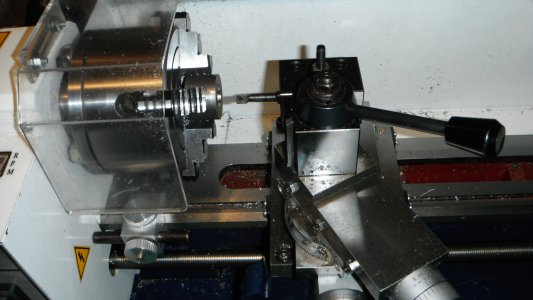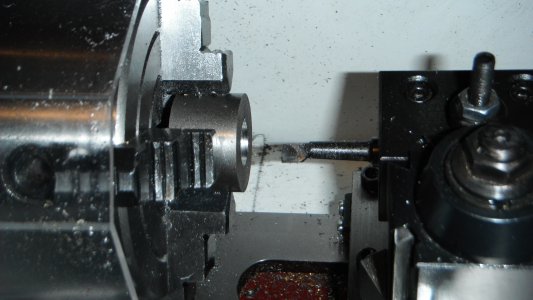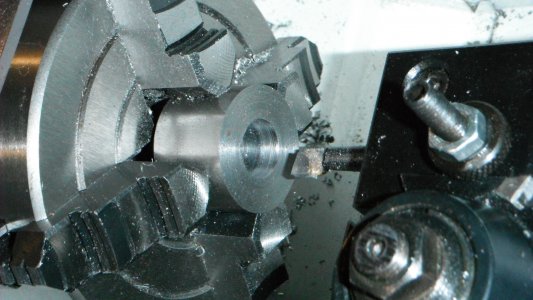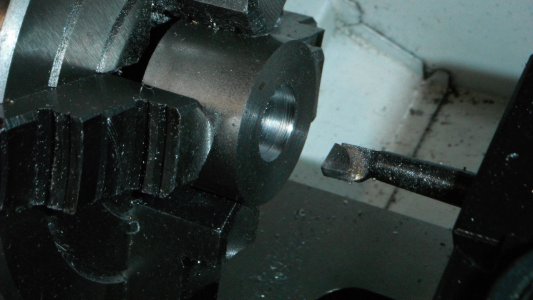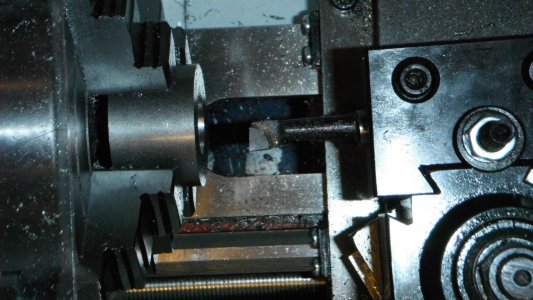It's official; boring is now my least favorite machining activity, supplanting even the dreaded parting off!
Most of the projects I've worked on to date haven't really required boring. I've done a few; a 1/4 inch deep, three-inch hole in a Lexan disk, a 3/4 inch hole in an aluminum rod about one inch deep, and now I need a 5/8 inch through-hole in a 7/8 inch deep piece of 1.25 inch drill rod. I first drilled it to 1/2 inch diameter, and then started boring using (inexpensive) carbide boring bars, though I don't know if the carbide makes any difference. I have very little experience with carbide, but I do know that it likes to run somewhat faster than HSS, so I've tried speeds from 250 up to 500 RPM.
My biggest problem has been adjusting the tool to avoid rubbing. The cutter is located slightly above center. I'm taking very light cuts (.005 inches per pass) but I seem to need to reset the tool every few passes because it's rubbing again and you can feel resistance while moving the carriage. I had expected the opposite; that the rubbing would be less of an issue as the hole opened up. Though, in fairness, the 1/2 inch hole is now about .560 inches, so there hasn't been very much opening up! I stopped because I wanted to get as good a finish as possible and didn't want to ruin the part.
My second problem is the finish, which is unpredictable. I'm cutting as I enter the part, and then I cut again (without changing the depth) on the way out. I've read that this will prevent or minimize bell-mouth. Sometimes the finish looks fine. Other times, it looks like grooves have formed at certain points. Sometimes I can hear something odd going on while cutting; it almost sounds like something's bouncing around randomly inside the part. I'm using the shortest boring bar that will reach all the way through the part with the smallest cutting surface due to the small initial diameter of the hole.
Since boring is considered a rudimentary lathe skill, I'd like to really learn what I'm doing wrong here. Can anyone shed some light or provide some suggestions? I appreciate any input!
Most of the projects I've worked on to date haven't really required boring. I've done a few; a 1/4 inch deep, three-inch hole in a Lexan disk, a 3/4 inch hole in an aluminum rod about one inch deep, and now I need a 5/8 inch through-hole in a 7/8 inch deep piece of 1.25 inch drill rod. I first drilled it to 1/2 inch diameter, and then started boring using (inexpensive) carbide boring bars, though I don't know if the carbide makes any difference. I have very little experience with carbide, but I do know that it likes to run somewhat faster than HSS, so I've tried speeds from 250 up to 500 RPM.
My biggest problem has been adjusting the tool to avoid rubbing. The cutter is located slightly above center. I'm taking very light cuts (.005 inches per pass) but I seem to need to reset the tool every few passes because it's rubbing again and you can feel resistance while moving the carriage. I had expected the opposite; that the rubbing would be less of an issue as the hole opened up. Though, in fairness, the 1/2 inch hole is now about .560 inches, so there hasn't been very much opening up! I stopped because I wanted to get as good a finish as possible and didn't want to ruin the part.
My second problem is the finish, which is unpredictable. I'm cutting as I enter the part, and then I cut again (without changing the depth) on the way out. I've read that this will prevent or minimize bell-mouth. Sometimes the finish looks fine. Other times, it looks like grooves have formed at certain points. Sometimes I can hear something odd going on while cutting; it almost sounds like something's bouncing around randomly inside the part. I'm using the shortest boring bar that will reach all the way through the part with the smallest cutting surface due to the small initial diameter of the hole.
Since boring is considered a rudimentary lathe skill, I'd like to really learn what I'm doing wrong here. Can anyone shed some light or provide some suggestions? I appreciate any input!


